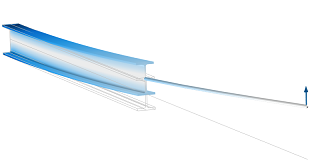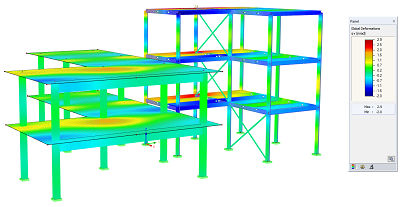CIV-E4010 - Finite Element Methods in Civil Engineering D, 01.03.2021-12.04.2021
This course space end date is set to 12.04.2021 Search Courses: CIV-E4010
Topic outline
-
This course is one of the elective courses for the Advanced Studies or Elective Studies modules of the MSc program Building Technology.

Figure 1. An example from Comsol 5.3A release highlights: Coupling Beams and Solids.

Figure 2. An example from RFEM tutorials: Introduction to Analysis and Design.
START
First of all, students are asked to register to the course in the WebOodi-system.
The course starts on Tuesday the 1st of February at 14.15 with lecture session via the Zoom-platform.
PEOPLEProfessor-in-Charge: associate professor Jarkko Niiranen
Lecturers: associate professor Jarkko Niiranen and professor Antti Niemi (Week 6)
Assistants: doctoral student Tuan Nguyen, assistant Tomi KankkunenLECTURES
Tuesdays 14--16 and Thursdays 14--16 via Zoom
EXERCISES
Theoretical assignments: Wednesdays 12--14 and Fridays 10--12 via Zoom
Computer assignments: Mondays 16--18 via ZoomWeek 1: no Monday computer session
ACTIONS AND WORKLOADSIt should be noticed that more than 50% of the hours related to the "holy trinity" teaching--studying--learning is related to independent studying (reading and preparation 26%, home assignments 27%), whereas contact teaching covers the smaller complement (lectures 18%, exercise sessions 27%, examination 2%).
The following nominal hours (total 133) should guarantee for a student with average prerequisites (grade 3, good) middle range learning outcomes (with the average grade 3, good).
Lectures 18%:
- 2 double-hours per week (total 24)
- attending the lectures: pre-browsing, listening, writing notes, asking etc.
Reading 18%:
- 2 double-hours per week (total 24)
- self-studies: reading and writing the derivations in the lecture slides and/or textbook
Theoretical Exercise Sessions 18%:
- 2 double-hours per week (total 24)
- advice hours for theoretical hands-on exercises (given by the assistants)
Computer Exercises Sessions 9%:
- 1 double-hour per week (total 12)
- advice sessions for software hands-on exercises (given by the assistants)
Theoretical Home Assignments 18%:
- 4 hours per week (total 24)
- 3-6 per week
- self-studies for theoretical, hands-on exercises: problem solving, calculating, writing solution documents
Computer Home Assignments 9%:
- 2 hours per week (total 12)
- 1-3 per week
- self-studies for software, hands-on exercises: reading manuals, programming, modeling, preparing solution plots
Final Exam and Preparation 10%:
- 3 + 10 hours (total 13)EXAMS
The first examination of year 2021 is on April 12 (13--16), the second one on May 31 (9--12).
LEARNING OUTCOMES
1. Recognising possibilities, advantages and risks of applying advanced computational methods and simulation tools in engineering problems
2. Understanding of the theoretical foundations of the advanced finite element methods (FEM) applied in civil engineering
3. Understanding the main assumptions and features of specialized structural elements (such as beams, plates and shells) and analysis types (such as linear and nonlinear static, eigenvalue and time-dependent problems)
4. Ability to apply the most relevant advanced finite element methods in civil engineering by implementing well-structured programs for solving
basic engineering problems
5. Ability to critically utilize advanced finite element software tools (such as Comsol and/or RFEM/Scia/Robot/Abaqus) for the most typical civil engineering problems
